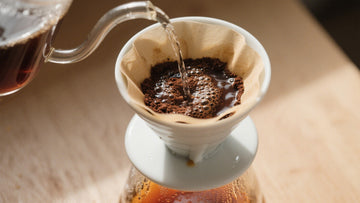Pour-over coffee isn’t just a brewing method—it’s a dance between water and coffee grounds, where every detail shapes the final cup. From the initial bloom to the rhythm of your pour, understanding the science behind water flow and grind size can transform your morning ritual. Let’s break down the key steps for Hario V60 and Chemex, two iconic pour-over tools, and explore how they impact flavor.
1. The Bloom: Unleashing Coffee’s Potential
When hot water first hits freshly ground coffee, a magical reaction occurs: degassing. Coffee beans trap carbon dioxide (CO₂) during roasting, and this gas escapes rapidly when water touches the grounds. This phase, called the bloom, is critical for even extraction.
-
Why it matters: CO₂ creates bubbles that repel water, preventing uniform contact with the grounds. A proper bloom (lasting 30–45 seconds) ensures gases escape, letting water penetrate deeply for balanced flavor.
-
How to do it: Pour just enough water (2–3x the coffee weight) to saturate the grounds, then pause. For Hario V60, use 18g coffee and 45g water; for Chemex (with its thicker filter), extend the bloom slightly to 50 seconds.
-
Science tip: Fresh coffee blooms more vigorously. Stale beans? They’ll fall flat.
2. Spiral Pouring: The Art of Control
After the bloom, it’s time to pour. The goal? Even extraction by wetting all grounds uniformly. This is where spiral pouring shines.
-
Why spiral? Coffee grounds extract differently based on water contact. Center-only pours create a “high and dry” zone in the middle, while outer edges over-extract. Spiraling ensures every particle gets equal love.
-
Hario V60 vs. Chemex:
-
V60: Its 60° cone and large drain hole demand precision. Start at the center, spiral outward to the edge, then back inward. Pour in 3–4 pulses (e.g., 60g → 120g → 180g) to maintain flow control.
-
Chemex: Its flat-bottomed design and thick filter slow drainage. Use a gentler spiral to avoid channeling (water finding paths of least resistance). Pour slower, keeping the water level just above the grounds.
-
Pro move: Use a gooseneck kettle for a thin, steady stream. A heavy-handed pour disrupts the coffee bed, leading to bitter or sour spots.
3. Grind Size: The Foundation of Flavor
Grind size dictates how quickly water extracts flavor compounds. Too fine? Over-extraction (bitterness). Too coarse? Under-extraction (sourness).
-
Hario V60: Favors a medium-fine grind (similar to table salt). Its fast flow rate requires smaller particles to resist over-extraction. Adjust based on roast:
-
Light roasts: Slightly finer to pull out complex acids.
-
Dark roasts: Coarser to avoid bitterness.
-
-
Chemex: Needs a medium-coarse grind (like sea salt). Its thick filter traps fines, so a coarser grind prevents clogging and ensures clarity.
-
Experiment: Use a burr grinder for consistency. If your coffee tastes weak, grind finer; if harsh, go coarser.
Putting It All Together: A Recipe for Success
1.Bloom: 18g coffee (V60) or 20g (Chemex) + 45–50g water, 45 seconds.
2.Pour: Spiral outward in pulses, maintaining a steady water level.
Total brew time: 2:30–3:30 (V60), 3:30–4:30 (Chemex).
3.Adjust: Taste your coffee. Is it bright but thin? Try a finer grind.
Bitter? Coarser or shorter pour.
The Takeaway
Pour-over coffee is a blend of art and science. By mastering bloom time, spiral pouring, and grind size, you control extraction to highlight sweetness, acidity, or body. Whether you use a Hario V60 or Chemex, remember: patience and precision reward you with a cup that’s uniquely yours.
So grab your kettle, grind some beans, and let the water flow—your perfect pour-over awaits. ☕






